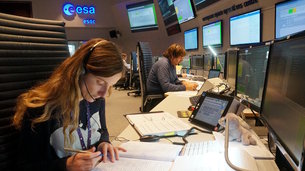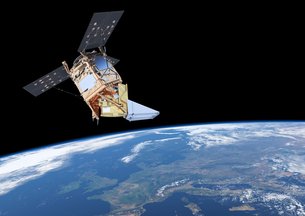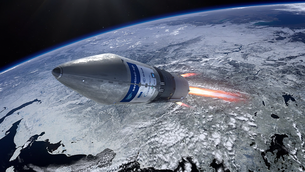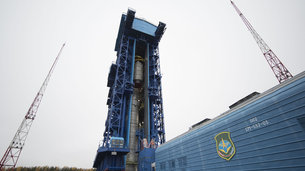4.09.2017
Sentinel-5 Precursor begins final journey to launch site

Stevenage, 30/08/2017 – Europe’s pollution monitoring satellite Sentinel-5 Precursor has left Airbus’ Stevenage site and is on its way to the launch site, the Plesetsk Cosmodrome in Russia. Launch is currently planned on 9 October on a Rockot rocket.
The journey that will last 5 days, will start with a flight to Moscow aboard an Antonov 124, followed by another flight to Archangelsk in the northwest of Russia. The last leg of the journey will be a train ride taking the satellite 200km south of Archangelsk to the Russian spaceport of Plesetsk.
Sentinel-5 Precursor is part of the global monitoring programme “Copernicus”, a joint European Commission–ESA undertaking which aims to acquire continuous and accurate Earth observation data and provide services to improve the management of the environment, understand and mitigate the effects of climate change and ensure civil security.
Sentinel-5 Precursor will provide essential atmospheric chemistry data to the Copernicus programme before the Sentinel-5 instrument becomes operational in 2021 on the MetOp Second Generation satellite.
Airbus was prime for Sentinel-5 Precursor, with three sites involved in development and manufacturing of the satellites and its components: Stevenage (UK - prime), Toulouse (France) and Friedrichshafen (Germany). The TROPOMI instrument was built by Airbus Netherlands.

Quelle: Airbus
---
Update: 27.09.2017
.
European satellite to be launched from Plesetsk on Oct 13
ADELAIDE (Australia). Sept 26 (Interfax) - The Sentinel-5B remote-sensing satellite will be launched by a Rokot LV from the Plesetsk cosmodrome on October 13, European Space Agency (ESA) Director General Johann-Dietrich Woerner told reporters on the sidelines of the International Astronomical Congress in Adelaide.
There is an agreement to launch the Sentinel-5B remote-sensing satellite on Friday, the 13th of October, he said, adding he was hopeful of the successful mission despite the launch date.
The future of the ExoMars project was a key item on the agenda of the meeting with the Russian delegation, Woerner said. According to him, the sides agreed on what they should deliver to one another for making the 2020 mission a success.
Woerner also lauded cooperation with Roscosmos.
Quelle: Interfax
+++
PREPARING TO FLY SENTINEL-5P
The teams that will fly Sentinel-5P are training intensively for launch, ensuring that everyone knows their job and can react to any emergency.
A ‘team of teams’ at ESA’s mission control centre has spent months preparing to assume control of Europe’s next Earth observation mission, and the final weeks before launch have been the most intense.
Sentinel-5P – the P refers to ‘precursor’ – is the first mission for Copernicus dedicated to monitoring our atmosphere.
The satellite carries the state-of-the-art Tropomi instrument that will map a multitude of trace gases such as nitrogen dioxide, ozone, formaldehyde, sulphur dioxide, methane, carbon monoxide and aerosols – all of which affect the air we breathe, and therefore our health, and our climate.
Expansion of the Sentinel fleet in orbit highlights the expertise of teams at ESA and their capability to fly ‘constellation’ missions, as Sentinel-5P will fly in tight coordination with the US Suomi-NPP mission.
The challenging task of flying Sentinel-5P throughout its planned seven-year mission starts just 93 minutes after liftoff on 13 October, set for 09:27 GMT (11:27 CEST), on a Rockot from Russia’s Plesetsk Cosmodrome.
Phoning home
That’s when the satellite, already in space after separating from the rocket some 14.5 minutes earlier, will make its first call home, signalling via a ground station in Sweden to ESA’s main control room in Darmstadt, Germany.
“It’s called ‘acquisition of signal’, and it’s the moment when the years of careful development and preparation for our mission control systems, and the months of training for our mission control teams, will prove their worth,” says flight operations director Pier Paolo Emanuelli.
That moment is one of the riskiest for the satellite: its rocket must have provided the right boost to put it into the planned orbit, and until its solar panels deploy to start generating power, it must survive on batteries, which will last only for a limited time.
“Once we get the signal, and establish a commanding link with the satellite, we’ll begin a critical series of activities and procedures to verify the satellite’s health, ensure we have solar power and full communications, activate systems like the startracker cameras for navigation and ensure that 5P is fully functional after the incredibly vigorous ride into space.”
These initial activities continue around the clock for the first three days, after which the team will switch to daytime work, if all goes well, and move on to the next phase of the mission: commissioning the Tropomi sensor.
Training for all possibilities
If anything does go wrong, ESA will be well prepared. Since mid-July, the mission control teams – including the operations engineers, flight dynamics specialists, teams from ground stations, the science and project teams and representatives from European industry – have conducted 20 simulations out of the planned 26.
Each runs for a full day, and employs sophisticated software to replicate the satellite and ground systems. Trainers can inject faults, errors and breakdowns into the simulation, testing the skill and knowledge of even the most experienced engineers and the teamwork and problem-solving abilities of everyone.
“The human factor is the one that determines the success of the mission. There is no single responsibility, and it is great to see our teams working together,” says spacecraft operations manager Daniel Mesples.
Quelle: ESA
---
Update: 7.10.2017
.
Launching 13 Oct from Plesetsk, new images of #Sentinel5P
encapsulation now



Quelle: ESA
-
EINLADUNG ZUM START DES SATELLITEN SENTINEL-5P IM RAHMEN VON COPERNICUS
Der nächste Satellit des europäischen Copernicus-Programms wird am 13. Oktober um 11.27 Uhr MESZ vom Kosmodrom Plessezk in Nordrussland aus gestartet. Vertreter der Medien sind eingeladen, den Start auf der Hauptveranstaltung im ESTEC, dem europäischen Weltraumforschungs- und Technologiezentrum der ESA im niederländischen Noordwijk, mitzuverfolgen.
Die Sentinel-Satellitenflotte wurde für die Bereitstellung der zahlreichen Daten und Bilder entworfen, die für das Copernicus-Programm der Europäischen Kommission von zentraler Bedeutung sind. Dieses einzigartige Umweltüberwachungsprogramm läutet einen Paradigmenwechsel bei der Wahrnehmung und dem Management unserer Umwelt, unserem Verständnis und Umgang mit den Auswirkungen des Klimawandels und dem Schutz unseres Alltags ein.
Der Satellit Sentinel-5P, wobei das P für „Precursor“, also „Vorläufer“, steht, dient als erste Copernicus-Mission der Überwachung unserer Atmosphäre. An Bord des Satelliten befindet sich insbesondere das hochentwickelte Instrument Tropomi, mit dem zahlreiche Spurengase wie Stickstoffdioxid, Ozon, Formaldehyd, Schwefeldioxid, Methan, Kohlenmonoxid und Aerosole kartiert werden, die alle Auswirkungen auf unsere Atemluft und somit unsere Gesundheit sowie unser Klima haben.
Mit einer Abtastbreite von 2600 km wird der Satellit jeden Tag unseren gesamten Planeten kartieren. Die Daten dieser neuen Mission werden anschließend vom Copernicus-Atmosphärenüberwachungsdienst für Vorhersagen zur Luftqualität und zur Bereitstellung von Datengrundlagen für künftige Beschlüsse genutzt.
Die Mission wird auch Daten für andere Dienste bereitstellen, wie die Überwachung von Vulkanasche für die Flugsicherheit oder zur Warnung vor hautschädigender hoher UV-Einstrahlung.
Wissenschaftler wiederum werden diese Daten auswerten, um uns ein besseres Verständnis wichtiger atmosphärischer Prozesse zu ermöglichen, die relevant für unser Klima und die Entstehung von Löchern in der Ozonschicht sind.
Sentinel-5P schließt die Lücke zwischen dem Satelliten Envisat, insbesondere seinem Instrument Sciamachy, und dem geplanten Start von Sentinel-5 und ergänzt außerdem die Daten von GOME-2 auf MetOp.
In Zukunft werden sowohl die geostationäre Mission Sentinel-4 als auch die in polarer Umlaufbahn befindliche Mission Sentinel-5 für den Copernicus-Atmosphärenüberwachungsdienst die Zusammensetzung der Atmosphäre erfassen. Beide Missionen werden als zusätzliche Nutzlasten auf EUMETSAT-Wettersatelliten betrieben. Bis dahin kommt Sentinel-5P eine wichtige Vorläuferfunktion bei der Überwachung und Verfolgung der Luftverschmutzung zu.
Sentinel-5P ist das Ergebnis der engen Zusammenarbeit zwischen der ESA, der Europäischen Kommission, dem niederländischen Raumfahrtbüro, der Industrie, Datennutzern und Wissenschaftlern. Der Satellit wurde von einem Konsortium aus 30 Unternehmen unter der Federführung der britischen und niederländischen Filialen von Airbus Defence and Space entworfen und gebaut.
Die jüngsten Neuigkeiten und Informationen zu dieser Mission sind auf der Webseite www.esa.int/Sentinel-5P abrufbar.
Auf Twitter kann die Mission über den Hashtag #Sentinel5P verfolgt werden.
Startveranstaltung im europäischen Weltraumforschungs- und Technologiezentrum der ESA (ESTEC)
10.00 Uhr Einlass
10.30 Uhr Begrüßungsansprache: Jan Wörner, Generaldirektor der ESA
Einführung: Josef Aschbacher, ESA-Direktor für Erdbeobachtungsprogramme
Ansprachen von Vertretern der Europäischen Kommission, des niederländischen Raumfahrtbüros sowie des Kgl. Niederländischen Meteorologischen Instituts
Vorträge verschiedener Fachleute über die Leistungen von Sentinel-5P sowie den künftigen gesellschaftlichen und wirtschaftlichen Nutzen dieser Mission
Live-Übertragung des Starts von der Startrampe in Plessezk und aus dem europäischen Raumflugkontrollzentrum der ESA (ESOC) in Darmstadt
11.27 Uhr Start von Plessezk
11.35 Uhr Mittagessen
12.45 Uhr Live-Übertragung der Abtrennung des Satelliten, der Entfaltung der Solarpaneele und des Empfangs des ersten Signals
Quelle: ESA
---
Update: 10.10.2017
.
SENTINEL-5P POISED FOR LIFTOFF

With four days to liftoff, the next Sentinel satellite is now on the launch pad at the Plesetsk Cosmodrome in northern Russia.
The rocket will be fuelled two days before launch, set for Friday at 09:27 GMT (11:27 CEST).
The Sentinel-5P satellite has been at the cosmodrome since early September going through a series of tests and being readied for the big day. After being sealed from view in the rocket fairing last week, it was rolled out to the launch pad on Saturday.
“This point in any project is always very emotional as most of the team have been working hard for many years, and it is the last time they will see their ‘baby’. I am proud to have such a dedicated team,” said Bill Simpson, the Sentinel-5P satellite and launcher manager.
“We are now preparing for the dress rehearsal and then launch. It is hard to believe we are so close to our goal.”
Once operational, Sentinel-5P will map the global atmosphere every day with a resolution as high as 7 × 3.5 km. At this detail, air pollution over cities can be detected.
The satellite carries the state-of-the-art Tropomi instrument to map a multitude of trace gases such as nitrogen dioxide, ozone, formaldehyde, sulphur dioxide, methane, carbon monoxide and aerosols.
The mission will contribute to EU Copernicus services such as volcanic ash monitoring for aviation safety and for services that warn of high levels of UV radiation which can cause skin damage. In addition, the measurements will improve our knowledge of important processes in the atmosphere related to the climate and to the formation of holes in the ozone layer.
Quelle: ESA
---
Update: 13.10.2017
.
SENTINEL-5P LAUNCH EVENT
Live from ESA’s technical heart in Noordwijk, the Netherlands, follow the event to celebrate the launch of the air quality monitoring Sentinel-5P satellite.



The first Copernicus mission dedicated to monitoring our atmosphere is set for launch from the Plesetsk Cosmodrome in northern Russia on 13 October at 09:27 GMT (11:27 CEST).
During the ESA event, a number of the key players in the mission will discuss building the satellite and its state-of-the-art Tropomi instrument. Tropomi will map a multitude of trace gases such as nitrogen dioxide, ozone, formaldehyde, sulphur dioxide, methane, carbon monoxide and aerosols – all of which affect the air we breathe.
The event will include live feeds from the Plesetsk Cosmodrome, as well as from ESA’s mission control in Darmstadt, Germany.
The live webstream will begin at 08:30 GMT (10:30 CEST) and end at 11:15 GMT (13:15 CEST).
Programme (all times in CEST):
| 10:30 | Welcome addresses by representatives from ESA and the European Parliament |
| 10:40 | Live broadcast from ESA’s control centre and ‘roll call’, followed by a discussion on the Copernicus programme and Sentinel-5P mission |
| 10:50 | Moderated discussion on Sentinel-5P hardware |
| 11:00 | Discussion on atmospheric data and applications |
| 11:15 | Social media questions answered live |
| 11:20 | Live broadcast from Russia and final countdown |
| 11:27 | Liftoff |
| 11:35 | Break |
| 12:50 | Event resumes; discussion with astronaut André Kuipers |
| 13:00 | Live broadcasts from Russia and ESA’s control centre: status update |
| 13:05 | Closing statements |
| 13:15 | End of live coverage from ESA in the Netherlands |









+++12.50





+++13.00





Sentinel-5p-Signal



+++







Quelle: ESTEC, ESA









